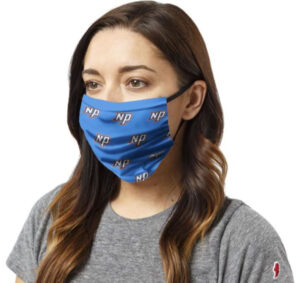Guide for students, faculty and staff on proper mask/face covering usage
This message updated Friday, Oct. 9, in light of new research indicating that neck gaiters are in fact effective at stopping the spread of COVID-19.
 SUNY New Paltz students, faculty and staff are required to wear masks or other face coverings indoors. Students do not need to wear masks in their residence hall rooms or suites, but should wear masks outside those spaces in their residence hall.
SUNY New Paltz students, faculty and staff are required to wear masks or other face coverings indoors. Students do not need to wear masks in their residence hall rooms or suites, but should wear masks outside those spaces in their residence hall.
Masks are also required outdoors whenever it is not possible to maintain six feet of social distance from others. These requirements apply both on and off campus.
Masks or other acceptable face coverings must cover your nose and mouth and meet the following criteria:
- Research shows that the most effective face masks are those made with tightly woven fabric to provide a good seal along the edges.
- (Update, Oct. 9): While early research indicated that neck gaiters made of thin, stretchable material may be less effective than other forms of masks, further study has shown that gaiters can in fact be effective at reducing the spread of coronavirus. For that reason, we are revising our guidance to confirm that neck gaiters and other similar coverings DO meet the College’s criteria for acceptable masking, and may be used.
- Masks with exhalation valves or vents, such as N95 masks, should NOT be worn to help prevent the person wearing the mask from spreading COVID-19 to others. It is acceptable to wear these masks only if you also wear an additional mask that meets the remaining criteria.
- A face shield is primarily used for eye protection for the person wearing it. At this time, it is not known what level of protection a face shield provides to people nearby from the spray of respiratory droplets from the wearer. There is currently not enough evidence to support the effectiveness of face shields for source control. Therefore, the Centers for Disease Control and Prevention (CDC) do not currently recommend use of face shields as a substitute for masks. Wearing a face shield WITH a mask is acceptable.
Proper use of masks and face coverings may create new challenges, or exacerbate existing challenges, for some individuals. We ask members of the New Paltz community to keep in mind the following:
- The use of masks, particularly home-made versions, may increase incidents of bias against communities of color. Masks and bandanas have a particularly troubled historical context in this country, much of which has been associated with urban violence and gang activity. Throughout the COVID-19 pandemic, Black, Indigenous and people of color (BIPOC) have expressed concern and shared experiences about masks exacerbating racial profiling. It is important to create spaces where students can look to their SUNY New Paltz community for support in navigating these experiences. Read more on this subject in this letter from Tanhena Pacheco Dunn, chief diversity officer and associate vice president for human resources, diversity & inclusion.
- People who are deaf or hard of hearing—or those who care for or interact with a person who is hearing impaired—should consider using a clear mask. Contact the Disability Resource Center if you require a clear mask for this purpose.
- People who are engaged in high-intensity activities like running may not be able to wear a mask if it causes difficulty breathing. If unable to wear a mask, consider conducting the activity in a location with greater ventilation and air exchange (for instance, outdoors versus indoors) and where it is possible to maintain physical distance from others.
- Campus employees who work in settings where masks may increase the risk of heat-related illness or cause safety concerns due to introduction of a hazard (for instance, straps getting caught in machinery) may consult with an occupational safety and health professional to determine the appropriate mask for their setting. Outdoor workers may prioritize use of masks when in close contact with other people, like during group travel or shift meetings, and remove masks when social distancing is possible.
Additional information about proper mask usage is available from the CDC, which recommends masks “as a simple barrier to help prevent respiratory droplets from traveling into the air and onto other people when the person wearing the mask coughs, sneezes, talks or raises their voice … This recommendation is based on what we currently know about the role respiratory droplets play in the spread of the virus that causes COVID-19, paired with emerging evidence from clinical and laboratory studies that shows masks reduce the spray of droplets when worn over the nose and mouth.”

